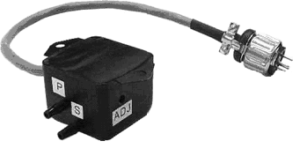

There are several situations that can affect the accuracy of the pitot-static instruments. The calibrated leak varies from model to model, but the average time for the diaphragm to equalize pressure is between 6 and 9 seconds. The reverse of this situation is true when an aircraft is descending. When the aircraft begins to increase altitude, the diaphragm will begin to contract at a rate faster than that of the calibrated leak, causing the needle to show a positive vertical speed. The area surrounding the diaphragm is vented to the static port through a calibrated leak (which also may be known as a "restricted diffuser"). The vertical speed is measured through a mechanical linkage to a diaphragm located within the instrument.

The vertical speed specifically shows the rate of climb or the rate of descent, which is measured in feet per minute or meters per second. The variometer, also known as the vertical speed indicator (VSI) or the vertical velocity indicator (VVI), is the pitot-static instrument used to determine whether or not an aircraft is flying in level flight.

Differential pressure sensing techniques can be used to produce angle of attack and angle of sideslip indications. Depending on the design, such air data probes may be referred to as 5-hole or 7-hole air data probes. Some pitot-static systems incorporate single probes that contain multiple pressure-transmitting ports that allow for the sensing of air pressure, angle of attack, and angle of sideslip data. When the aircraft climbs, static pressure will decrease. It incorporates a second coaxial tube (or tubes) with pressure sampling holes on the sides of the probe, outside the direct airflow, to measure the static pressure. A pitot-static tube effectively integrates the static ports into the pitot probe. An alternative static port may be located inside the cabin of the aircraft as a backup for when the external static port(s) are blocked. With this positioning, an average pressure can be taken, which allows for more accurate readings in specific flight situations. In situations where an aircraft has more than one static port, there is usually one located on each side of the fuselage. Some aircraft may have a single static port, while others may have more than one.

The static port is most often a flush-mounted hole on the fuselage of an aircraft, and is located where it can access the air flow in a relatively undisturbed area. The static pressure is obtained through a static port. When airspeed increases, the ram air pressure is increased, which can be translated by the airspeed indicator. By situating the pitot tube in such a location, the ram air pressure is more accurately measured since it will be less distorted by the aircraft's structure. The pitot tube is most often located on the wing or front section of an aircraft, facing forward, where its opening is exposed to the relative wind. The pitot pressure is a measure of ram air pressure (the air pressure created by vehicle motion or the air ramming into the tube), which, under ideal conditions, is equal to stagnation pressure, also called total pressure. The pitot pressure is obtained from the pitot tube. The static pressure is used in all measurements, while the pitot pressure is used only to determine airspeed. These pressures can be measured either from the static port (static pressure) or the pitot tube (pitot pressure). It works by measuring pressures or pressure differences and using these values to assess the speed and altitude. The pitot-static system of instruments uses the principle of air pressure gradient. Static ports fitted to an Airbus A330 passenger airliner.


 0 kommentar(er)
0 kommentar(er)
